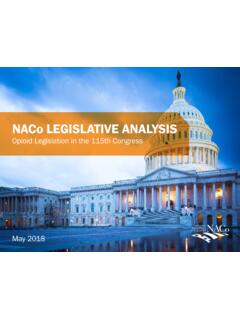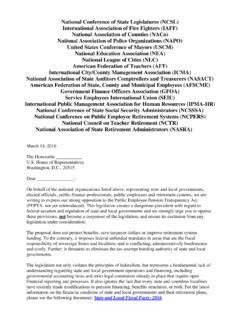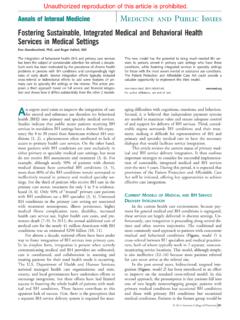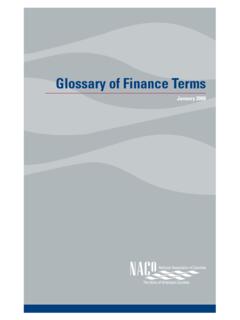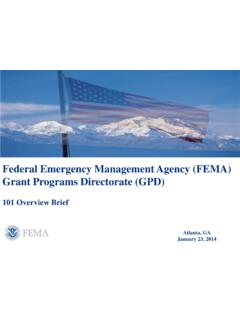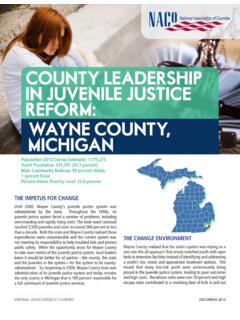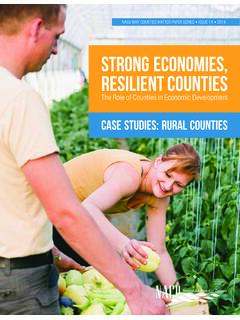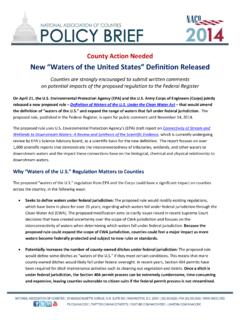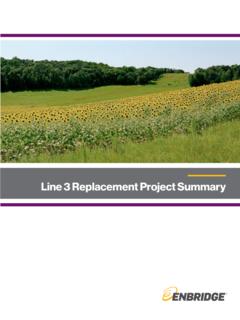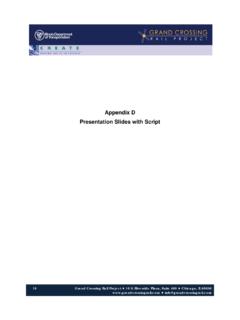Transcription of Definition of Waters of the United States” Under …
1 Definition of Waters of the United states Under the Clean water Act Summary of Final Regulation Published by EPA and Corps (As of June 2, 2015) 1 Key Terms Current EPA/Corps Regulations Proposed Rule Final Rule Preliminary Analysis Waters of the (WOTUS) Definition 40 CFR (s) The term Waters of the United states means: Define Waters of the United states for all sections (including sections 301, 311, 401, 402, 404) of the CWA to mean: For purposes of the Clean water Act, 33 1251 et. seq. and its implementing regulations, subject to the exclusions in paragraph (2) of this section, the term Waters of the United states means: NOTE: This rule will be finalized 60 days after publication in the Federal Register Traditional Navigable Waters All Waters which are currently used, were used in the past, or may be susceptible to use in interstate or foreign commerce, all Waters which are subject to the ebb and flow of the tide.
2 (1) All Waters which are currently used, were used in the past, or may be susceptible to use in interstate or foreign commerce, including all Waters which are subject to the ebb and flow of the tide; (i) All Waters which are currently used, were used in the past, or may be susceptible to use in interstate or foreign commerce, including all Waters which are subject to the ebb and flow of the tide; NO CHANGE These Waters are referred to as traditionally navigable Waters of the For the purposes of CWA jurisdiction, Waters are considered traditional navigable Waters if: They are subject to section 9 /10 of the 1899 Rivers and Harbors Appropriations Act A federal court has determined the water body is navigable-in-fact Under law Waters currently used (or historically used) for commercial navigation, including commercial waterborne recreation (boat rentals, guided fishing trips, etc.)
3 Definition of Waters of the United states Under the Clean water Act Summary of Final Regulation Published by EPA and Corps (As of June 2, 2015) 2 Key Terms Current EPA/Corps Regulations Proposed Rule Final Rule Preliminary Analysis Interstate Waters All interstate Waters , including interstate wetlands ; (2) All interstate Waters , including interstate wetlands; (i) All interstate waters1, including interstate wetlands; NO CHANGE Territorial Seas The territorial seas2; and (6) The territorial seas; (iii) The territorial seas; NO CHANGE Impoundments All impoundments of Waters otherwise defined as Waters of the Under this Definition ; (4) All impoundments of a traditional navigable water , interstate water , the territorial seas or a tributary; (iv) All impoundments of Waters otherwise identified as Waters of the Under this section.
4 NO SIGNIFICANT CHANGE Impoundments such as berms, dikes, levees and dams may be considered jurisdictional because they are subject to seepage Tributaries Tributaries of Waters for navigable and interstate, territorial seas and impoundments of Waters (5) All tributaries of a traditional navigable water , interstate water , the territorial seas or impoundment; (v) All tributaries of Waters identified on pages 15-16 of this chart NEW LANGUAGE The final rule defines, for the first time, the Definition of a tributary: A tributary has a bed, bank and ordinary high water mark A tributary contributes flow, directly or indirectly, to a WOTUS The rule states that a tributary can be a natural, man-altered or man-made water and includes Waters such as rivers, streams, canals, and ditches and can flow perennially, intermittently or ephemerally Refer to tributary Definition on pages 15-16 of the chart 1 Waters , such as lakes, ponds, streams, tributaries, etc.
5 Are considered interstate Waters if they flow across state boundaries, even if they are not considered navigable and do not connect to a WOTUS 2 Territorial seas are defined as the belt of the seas measured from the line of the ordinary low water along that portion of the coast which is in direct contact with the open sea and the line marking the seaward limit of inland Waters , and extending seaward a distance of three miles Definition of Waters of the United states Under the Clean water Act Summary of Final Regulation Published by EPA and Corps (As of June 2, 2015) 3 Key Terms Current EPA/Corps Regulations Proposed Rule Final Rule Preliminary Analysis Adjacent Wetlands adjacent to Waters (other than Waters that are themselves wetlands) identified in paragraphs (a) through (f) of this Definition .
6 7) All Waters , including wetlands, adjacent to a traditional navigable water , interstate water , the territorial seas, impoundment or tributary; (vi) All Waters adjacent to navigable and interstate Waters , territorial seas and impoundments, including wetlands, ponds, lakes, oxbows, impoundments and similar Waters ; NEW LANGUAGE This is a significant change current Corps regulations refer to wetlands adjacent to WOTUS. The final rule encompasses all Waters adjacent to WOTUS The entire water is adjacent if any part of the water is bordering, continuous or neighboring.
7 These terms, including significant nexus, are further defined on pages 13-19 of this chart. The term adjacent is relevant when assessing 100-year floodplain designations, high tide lines and ordinary high water mark---It may encompass those areas separated by roads, berms and other structures Regional Consideration Criteria All other Waters such as interstate lakes, rivers, streams (including intermittent streams), mudflats, sandflats, wetlands, sloughs, prairie potholes, wet meadows, playa lakes, or natural ponds the use, degradation, or destruction of which would affect or could affect interstate or foreign commerce including any such Waters .
8 3) And on a case-specific basis, other Waters , including wetlands, provided that those Waters alone, or in combination with other similarly situated Waters , including wetlands, located in the same region, have a significant nexus to a traditional navigable water , interstate water or the territorial sea (vii) All Waters , where they are determined, on a case-specific basis, to have a significant nexus to navigable Waters , interstate Waters and the territorial sea. These Waters are similarly situated and shall be combined, for purposes of a significant nexus analysis.
9 In the watershed that drains to the nearest navigable or interstate Waters or territorial seas Waters identified in this paragraph shall not be combined adjacent Waters NEW LANGUAGE Regional water features that have a connection to a WOTUS may be jurisdictional These water features will be aggregated together it is difficult to exempt one water feature if others are jurisdictional More Waters in a broader area will be analyzed together Definition of Waters of the United states Under the Clean water Act Summary of Final Regulation Published by EPA and Corps (As of June 2, 2015) 4 Key Terms Current EPA/Corps Regulations Proposed Rule Final Rule Preliminary Analysis Regional Consideration Criteria (continued) when performing a significant nexus analysis If Waters identified in this section are also an adjacent water , they are considered an adjacent water and no case-specific significant nexus analysis is required (A) Prairie potholes3 (B) Carolina bays and Delmarva bays4 (C) Pocosins5 (D) Western vernal pools6 (E)
10 Texas coastal prairie wetlands7 This Definition is relevant for counties that own facilities and/or infrastructure near these regional water features It will be difficult to do any projects around these Waters without getting a federal permit Commerce Clause Language (i) Which are or could be used by interstate or foreign travelers for recreation or other purposes; (ii) From which fish or shellfish are or could be taken and sold in interstate or foreign commerce; or (iii) Which are used or could be used for industrial purposes by industries in interstate commerce (i) through (iii) eliminated (i) through (iii) eliminated DELETED The agencies considered this section duplicative language 3 Prairie potholes are primarily freshwater marshes found in the Upper Midwest (especially North Dakota, South Dakota, Wisconsin and Minnesota) 4 The Carolina bays (also called Delmarva bays)
